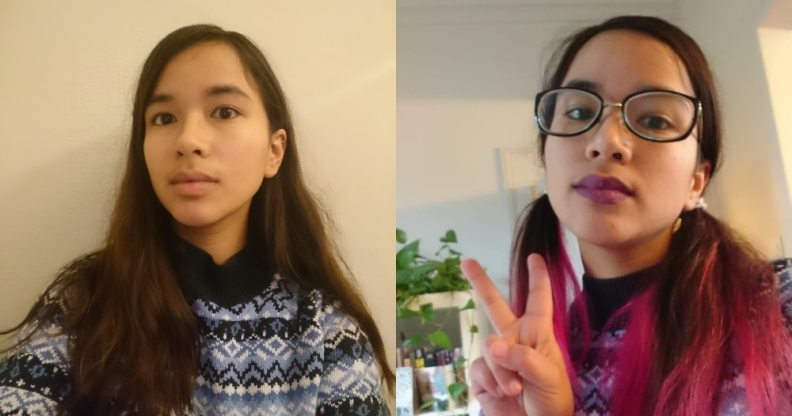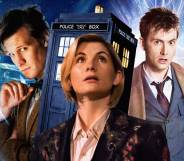Accepting myself as a lesbian and finding my tribe taught me how to finally love my own body

Pippa Stark. (Just like Us)
Pippa Sterk, an ambassador for British LGBTQ+ young people’s charity Just Like Us, writes for PinkNews about how lesbians and her own attraction to women taught her to finally love her body.
Anyone who has ever visited the Netherlands (or spotted a Dutch tourist abroad) will tell you that there is a quintessential Dutch ‘look’: tall, slim, confident, straight back, pale-skinned and athletic. A nation of supermodels.
Growing up in this country as a short, brown-skinned, anxious and chubby teenager, nobody needed to tell me that my body didn’t fit in because it was so glaringly obvious.
By age 12, I’d learned to hide my body, pick at my skin, analyse my face for any flaws (which I would inevitably find), in between episodes of trying not to look at my body at all, because I knew it would just make me sad.
I thought this was perfectly normal behaviour.
As the late-2000s had some of the heights of social panics around eating disorders, we were bombarded with media messages that warned us not to feel bad about ourselves. Every television show had its ‘body image’ special episode and the most popular YA novel series in the Netherlands at the time warned us of the dangers of purging.
Unfortunately, this wasn’t always helpful, as there is still a massive disjunction between how body image is treated in fiction, and how it is treated in real life.
Firstly, fiction tends to treat poor self-image as an individual issue, with individual causes and individual solutions.
If only we believed in our self-worth, all our problems would be solved! Never mind that weight discrimination is so systemic that it can lead to worse medical treatment. Never mind that in film, visible bodily differences like scarring, are often attributed to villainous characters, as if looking different actually makes you a bad person.
This brings me to my second, and maybe more crucial point: many stories tend to only see the tragedy in poor self-image when it happens in characters who conform to conventional beauty standards.
Everyone can feel sorry for the beautiful girl who simply doesn’t see how attractive she is. But if you actually are chubby or hairy, if you do have bad posture, greasy hair, or spotty skin, we are often told that our bodies are wrong, and maybe we should ‘improve’ ourselves.
Telling people to just be proud of their bodies only goes so far when this message does not reverberate around you. Looking back on my behaviour when I was a teenager, I am amazed at the lengths I went to in order to hide my body, and how convinced I was that nothing was wrong with me thinking this way about myself.
After all, I thought I was right. I thought I wasn’t like the beautiful girls in my school who had their unfounded insecurities, I was actually beyond any help.
All this started to change slowly, the moment I started coming to terms with my attraction to women. Throughout my youth, my image of what a ‘lesbian‘ looked like was primarily shaped by film and television, which seemed to operate along the premise that gender non-conformity was directly tied to how likeable a person was – feminine, long-haired, thin lesbians were nice and agreeable, but fat, hairy, pierced butches were antagonists.
There was also no option to be anything in-between these two false opposites.
Stereotyping lesbians leads people to see us as only one thing, and often something that is laden with negative connotations – the idea that lesbians are inherently ‘man-hating’ or ‘unattractive’ for instance.
This has led to 68 per cent of lesbians delaying coming out. But these stereotypes are reductive and don’t do justice to the real diversity within lesbian communities.
Despite these stereotypes playing around in my head, the moment I became involved in actual LGBTQ+ communities, it became clear to me how varied the category of ‘lesbian’ actually was, and how varied people’s tastes in these communities were.
I started meeting more masculine women, women who were fat, women who were tattooed, women who had visible disabilities, women who had a similar skin tone to me, women who were intentionally going against beauty standards, and women who simply didn’t seem to care that much.
More importantly, I saw all these women being desired, having friends, partners, and communities that cared about them, not despite their differences, but because of them.
Fatness, female masculinity, and everything else that makes bodies unique were not just tolerated, but actively celebrated.
Then, as I learned more about lesbian history, I saw pictures of generations of lesbians before me, and many examples of women who had defied gender norms in times and environments that were even less accepting of this than the current age.
They were women who are now hailed as pioneers of art, academia, activism, and liberation, and again no two of them looked the same.
I slowly started realising that my admiration of these women in all their bodily diversity, made it easier to accept the aspects of my body that I’d found difficult to appreciate.
This is not to say that lesbian spaces are free from pressure to conform to certain standards. Unfortunately, our communities do not exist in vacuums from prejudice, and there is racism, fatphobia, and ableism that needs to be addressed here too.
However, I know that when I walk into a room full of lesbians, I will most likely see a wider range of bodies than I saw in the media or in my secondary school growing up. My own body is simply one oddity among many, not measured or evaluated against an arbitrary standard.
Accepting myself as a lesbian and finding my lesbian community has helped me finally feel at home in my body.

